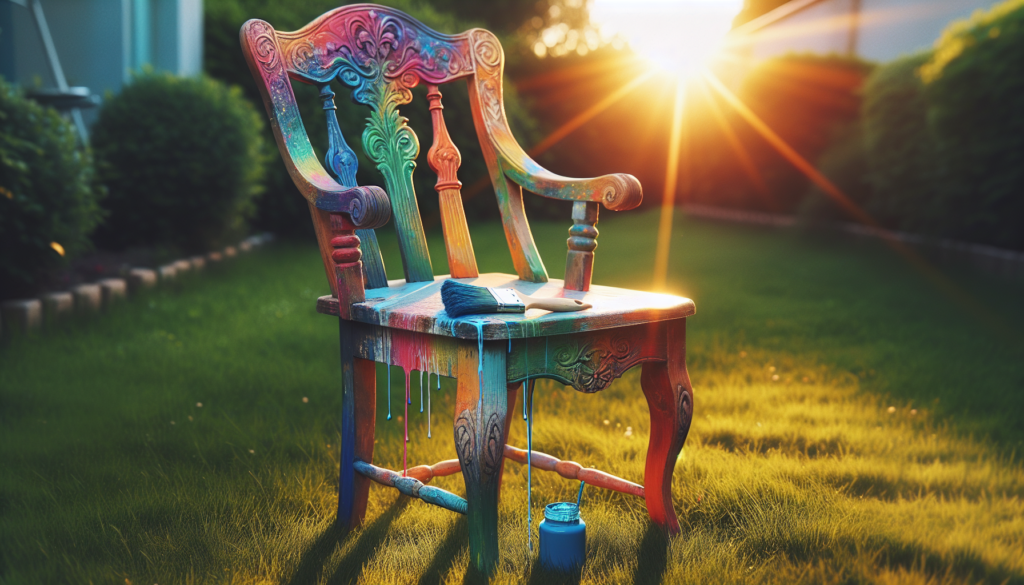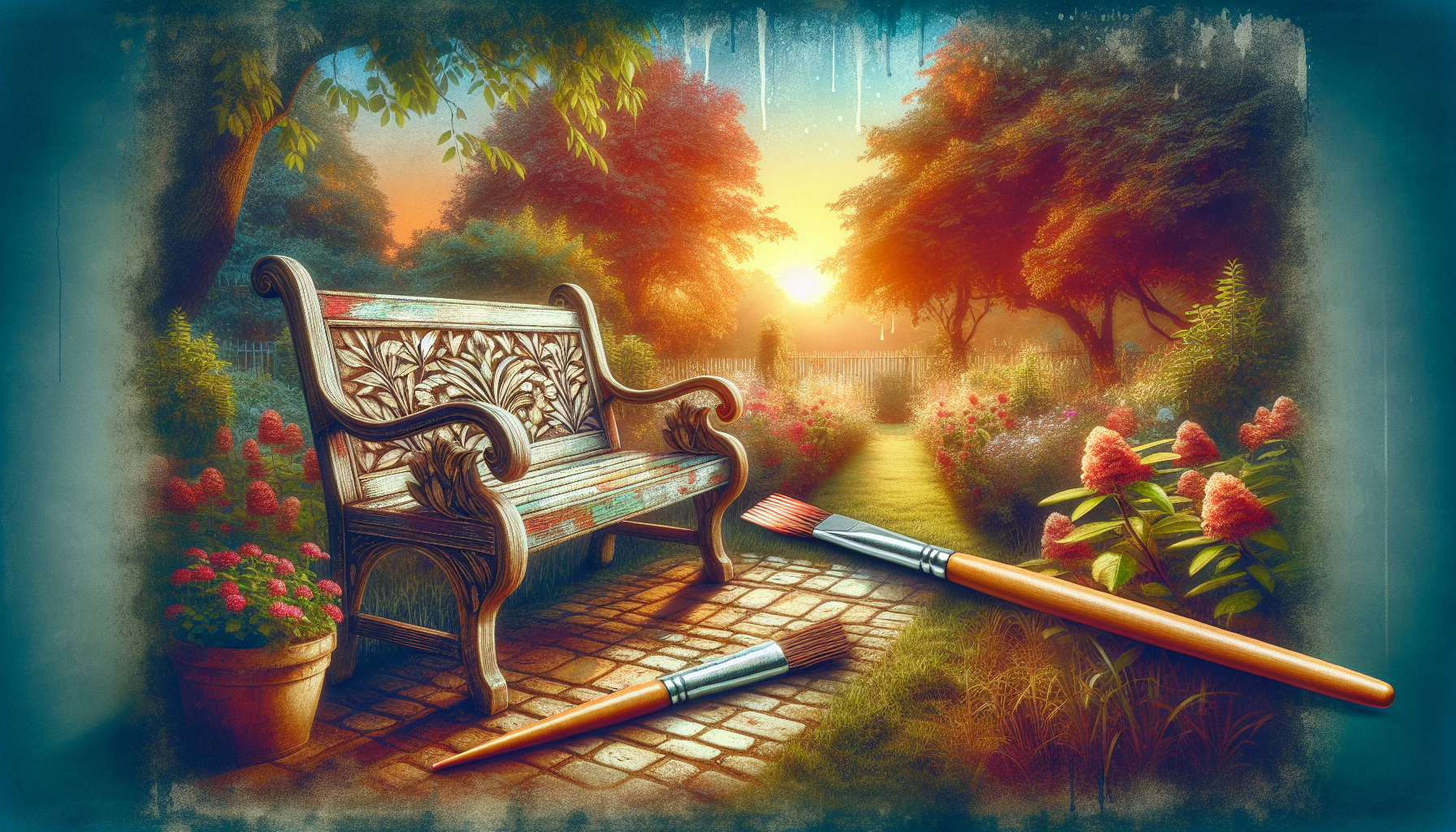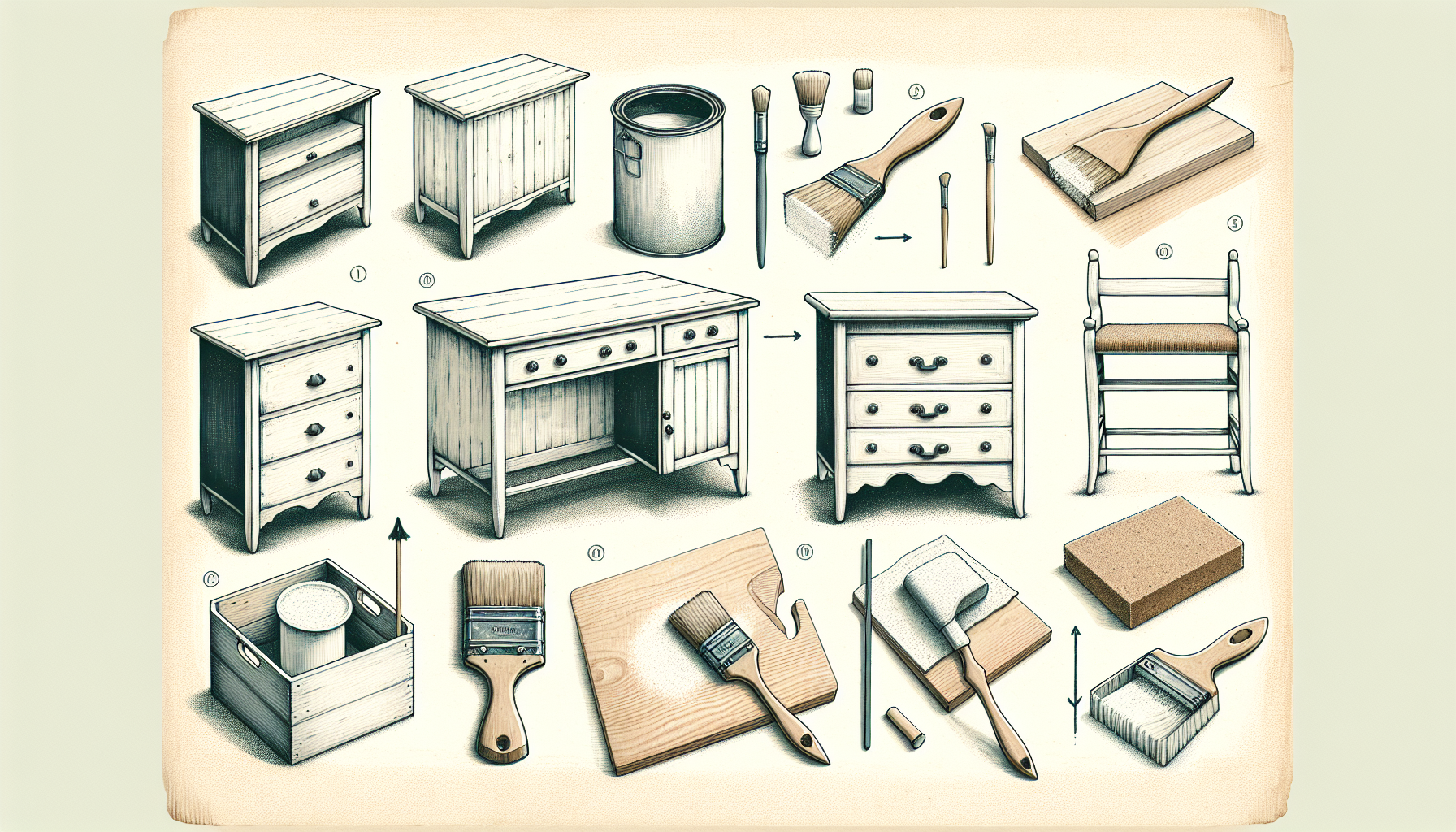When it comes to painting outdoor surfaces, finding the right type of paint can be a challenge. Are you wondering if chalk paint is suitable for outdoor use? This article explores the question “Can You Use Chalk Paint Outside?”. We will delve into the properties of chalk paint, its durability, and how it fares in various weather conditions. By the end, you will have a clear understanding of whether or not chalk paint is a viable option for your outdoor painting projects.
What is chalk paint?
Definition
Chalk paint is a type of water-based paint that provides a matte finish and a velvety, chalky texture when dry. It is named for its resemblance to the finish of traditional chalkboards. Unlike traditional paint, chalk paint does not require priming or sanding before application, making it a popular choice for both indoor and outdoor projects.
Characteristics
Chalk paint has several distinctive characteristics that make it a desirable option for outdoor use. It has excellent coverage and adheres well to various surfaces, including wood, metal, plaster, and even plastic. The thick consistency of chalk paint allows for easy application and minimal brush strokes. Once dry, chalk paint creates a durable finish that is resistant to chipping and peeling, making it ideal for withstanding the rigors of outdoor elements.
Advantages of chalk paint for outdoor use
Versatility
One of the major advantages of chalk paint for outdoor use is its versatility. It can be used on a wide range of surfaces, such as furniture, planters, pots, fences, mailboxes, and door and window frames. This allows you to easily transform and update outdoor elements without the need for expensive replacements.
Durability
Chalk paint is known for its durability, making it a great choice for outdoor projects. It creates a strong bond with the surface, providing long-lasting protection against weather conditions and daily wear and tear. When properly sealed and maintained, chalk paint can withstand rain, snow, sun exposure, and other outdoor elements without fading or deteriorating.
Ease of application
Applying chalk paint is a straightforward process, even for beginners. Since it does not require any priming or sanding, you can save time and effort when painting outdoor surfaces. The thick consistency of chalk paint allows for smooth application and provides good coverage with fewer coats. This ease of application makes it a convenient choice for DIY enthusiasts and professionals alike.
Wide color range
Chalk paint comes in a wide variety of colors, giving you plenty of options to choose from when designing your outdoor space. Whether you prefer neutral tones or vibrant shades, there is a chalk paint color that will suit your taste. Additionally, chalk paint can be easily mixed together to create custom colors, allowing for endless possibilities in outdoor design.

Considerations before using chalk paint outside
Weather conditions
Before using chalk paint outside, it’s important to consider the weather conditions in your area. Extreme temperature variations, excessive humidity, and prolonged exposure to direct sunlight can affect the longevity and performance of chalk paint. If you live in an area with harsh weather conditions, it may be necessary to take extra precautions or choose a different type of paint suitable for outdoor use.
Surface preparation
Proper surface preparation is crucial for achieving optimal results when using chalk paint outside. Start by cleaning the surface thoroughly to remove any dirt, dust, or grease that may affect the paint’s adhesion. Sanding the surface will provide a rough texture for better paint adhesion. For certain surfaces, such as previously painted or stained wood, priming may be necessary to ensure proper coverage and durability.
Protection
To protect chalk paint from outdoor elements, it is recommended to apply a clear coat or sealant after the paint has dried. This adds an additional layer of protection and helps to maintain the paint’s color and finish. The type of sealant used will depend on the specific requirements of your project, such as the desired level of gloss or protection against UV rays. Properly sealing chalk paint can significantly enhance its durability and longevity.
Maintenance
While chalk paint is durable and long-lasting, regular maintenance is still necessary to keep your outdoor surfaces looking their best. Periodic cleaning with a mild soap and water solution will help remove dirt and debris, preventing the build-up of grime. In high-traffic areas or where the paint may be exposed to excessive wear, touch-ups may be required over time. Additionally, reapplication of a protective layer, such as wax or clear coat, may be necessary to maintain the paint’s appearance and performance.
Preparing the surface for chalk paint
Cleaning the surface
Before applying chalk paint outside, it is essential to clean the surface thoroughly. Use a mild soap or detergent mixed with water to remove any dirt, grease, or other contaminants. Scrub the surface gently with a soft brush or sponge, then rinse thoroughly with clean water and allow it to dry completely before proceeding.
Sanding
For optimal adhesion, it is recommended to sand the surface lightly before applying chalk paint. This creates a rough texture that allows the paint to grip the surface better. Use a fine-grit sandpaper or sanding block to sand the surface in circular motions, paying attention to any rough or glossy areas. After sanding, remove any dust or debris with a clean cloth or brush.
Priming
In some cases, priming may be necessary before applying chalk paint. This is especially true if you are painting over a previously painted or stained surface, or if the surface is porous or prone to stains. Priming helps ensure proper coverage and adhesion of the chalk paint. Choose a primer that is suitable for the surface you will be painting and follow the manufacturer’s instructions for application and drying time.
Applying sealant
Once the chalk paint has dried completely, it is recommended to apply a sealant to protect the paint from outdoor elements. This will help maintain the paint’s color and finish, as well as provide added durability. There are various types of sealants available, such as clear coat, wax, or polyurethane. Choose a sealant that is suitable for your project and apply it according to the manufacturer’s instructions.

Applying chalk paint outside
Choosing appropriate tools
When applying chalk paint outside, it is important to use the appropriate tools for the job. A high-quality synthetic bristle brush or foam roller will provide smooth and even coverage. Avoid using natural bristle brushes, as these may leave brush marks or shed bristles on the painted surface. If necessary, use a smaller brush or sponge applicator for detailed or hard-to-reach areas.
Painting techniques
To achieve a professional-looking finish with chalk paint, it is recommended to use smooth and even strokes. Apply the paint in thin layers, allowing each layer to dry completely before applying the next. If desired, you can create various decorative effects by using different painting techniques, such as dry brushing, distressing, or layering colors. Experiment with different techniques on a test surface before starting your project to determine the desired outcome.
Allowing drying time
After applying each layer of chalk paint, it is crucial to allow sufficient drying time before proceeding. The exact drying time will depend on factors such as humidity, temperature, and the thickness of the paint layers. Generally, chalk paint dries to the touch within 30 minutes to an hour, but it is recommended to wait at least 24 hours before applying a sealant or handling the painted surface.
Protecting chalk paint in outdoor environments
Applying clear coat
To protect chalk paint in outdoor environments, applying a clear coat is highly recommended. Clear coat provides an extra layer of protection against UV rays, moisture, and other outdoor elements. It also helps to maintain the paint’s color and finish over time. Choose a clear coat that is specifically formulated for outdoor use and apply it according to the manufacturer’s instructions.
Using wax
Wax is another popular option for protecting chalk paint outdoors. It provides a layer of protection while also enhancing the paint’s appearance by adding depth and a subtle sheen. Apply a thin layer of wax using a soft cloth or wax brush, working in small sections at a time. Allow the wax to dry for the recommended time, then buff it gently with a clean cloth to achieve a smooth and satin-like finish.
Applying polyurethane
Polyurethane is a durable and long-lasting sealant that is suitable for protecting chalk paint in outdoor environments. It creates a strong barrier against moisture, UV rays, and other harsh weather conditions. Before applying polyurethane, make sure the chalk paint is completely dry. Apply the polyurethane using a synthetic bristle brush or foam roller, following the manufacturer’s instructions for application and drying time.
Maintaining chalk paint outdoors
Cleaning
Regular cleaning is essential to maintain the appearance and longevity of chalk paint in outdoor environments. Use a mild soap or detergent mixed with water to clean the painted surface, then rinse thoroughly with clean water. Avoid using harsh chemical cleaners or abrasive materials, as these can damage the paint. After cleaning, allow the surface to dry completely before applying any touch-ups or protective layers.
Touch-ups
Over time, outdoor surfaces painted with chalk paint may require touch-ups due to wear and tear or exposure to the elements. To touch up small areas, use a small brush or sponge applicator to apply a thin layer of chalk paint, blending it seamlessly with the surrounding painted surface. For larger areas, consider repainting the entire section to ensure an even and consistent finish.
Reapplication of protective layers
The protective layers applied to chalk paint outdoors, such as clear coat, wax, or polyurethane, may need to be reapplied periodically to maintain their effectiveness. The frequency of reapplication will depend on various factors, including weather conditions, exposure to sunlight, and the level of wear on the painted surface. Regularly inspect the painted surface and take note of any signs of fading, chipping, or peeling to determine when it is time to reapply the protective layers.
Projects suitable for chalk paint outdoors
Furniture
Chalk paint is an excellent choice for updating and transforming outdoor furniture. Whether you have wooden chairs, metal tables, or plastic loungers, chalk paint can be applied to create a beautiful and durable finish. Consider using different colors or techniques to add a personalized touch to your outdoor seating area.
Planters
Chalk paint provides a unique and stylish option for revamping outdoor planters. Whether clay, concrete, or plastic, planters can be easily painted with chalk paint to create a cohesive and vibrant look in your garden or patio. Experiment with different colors or patterns to complement your outdoor plants and flowers.
Pots
If you have plain ceramic or terracotta pots, chalk paint can instantly transform them into eye-catching design elements. Use chalk paint to add color and personality to your outdoor space by painting the pots in your preferred shades. Consider using stencils or freehand painting to create intricate designs and patterns.
Fences
Unleash your creativity by using chalk paint to enhance your outdoor fences. Whether wood, metal, or vinyl, fences can be painted with chalk paint to create a unique and visually appealing backdrop for your outdoor space. Consider using different colors or even creating a mural to showcase your personal style.
Mailboxes
Give your mailbox a fresh and vibrant look with the help of chalk paint. Whether a traditional or modern-style mailbox, chalk paint can be used to update its appearance and make it stand out. Choose a color that complements your house exterior and consider adding decorative elements, such as stencils or hand-painted designs, to showcase your address or personal flair.
Door and window frames
Chalk paint can breathe new life into your outdoor door and window frames. Whether wooden, metal, or even PVC, chalk paint can be applied to create a fresh and stylish look. Consider using contrasting colors to make your frames pop or opt for a more subtle and cohesive color scheme that complements your house exterior.
Common FAQs about using chalk paint outside
Can chalk paint withstand rain?
Chalk paint is known for its durability and ability to withstand outdoor elements, including rain. When properly sealed and maintained, chalk paint forms a protective barrier that helps prevent water damage. However, it is important to note that excessive exposure to rain or prolonged contact with water may eventually cause wear or damage to the paint. Regular inspections and touch-ups are recommended to maintain the paint’s integrity.
Will chalk paint fade in the sun?
Chalk paint is known for its colorfastness and resistance to fading. However, prolonged exposure to direct sunlight can cause some fading over time. To minimize fading, it is important to apply a clear coat or sealant specifically designed for outdoor use. Additionally, periodic inspections and reapplication of protective layers may be necessary to maintain the paint’s color and finish.
Can you use chalk paint on plastic surfaces?
Yes, chalk paint can be used on plastic surfaces, although some surface preparation may be required. It is recommended to clean the plastic surface thoroughly and lightly sand it to create a rough texture for better paint adhesion. Additionally, applying a suitable primer designed for plastic surfaces can further enhance the paint’s adhesion and durability. Always follow the manufacturer’s instructions for surface preparation and application when using chalk paint on plastic.
Can outdoor chalk paint be used indoors?
Yes, outdoor chalk paint can be used indoors. However, it is important to note that outdoor chalk paint may have additional properties, such as UV resistance or extra durability, that may not be necessary for indoor use. Additionally, outdoor chalk paint may have a stronger odor or require longer drying times compared to indoor-specific chalk paint. Consider these factors and choose the appropriate type of chalk paint for your indoor projects.
Can you apply chalk paint directly on wood?
Chalk paint can be applied directly on wood surfaces without the need for sanding or priming in most cases. This is one of the advantages of chalk paint, as it saves time and effort in the preparation process. However, if the wood surface is heavily stained or varnished, it is recommended to clean it thoroughly and lightly sand it to ensure proper paint adhesion. Always follow the manufacturer’s instructions and test the paint on a small area before proceeding with the entire project.
Conclusion
Chalk paint offers a versatile, durable, and easy-to-use option for outdoor projects. Its ability to adhere well to various surfaces and provide a matte, velvety finish makes it a popular choice among DIY enthusiasts and professionals alike. By considering weather conditions, properly preparing the surface, applying protective layers, and following proper maintenance techniques, you can enjoy the beauty and longevity of chalk paint in your outdoor spaces. With the wide range of projects suitable for chalk paint, you can bring new life to furniture, planters, fences, and more, while adding your personal touch to your outdoor oasis.



